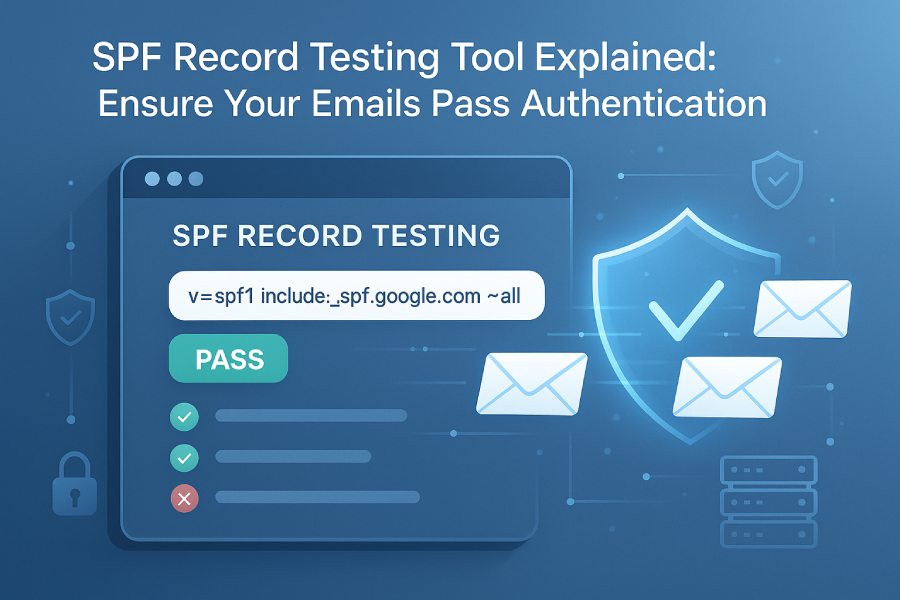Understanding SPF Records: What Are They and Why They Matter
An SPF record, short for Sender Policy Framework record, is a specific type of DNS TXT record published on a domain’s DNS management system. This SPF record defines which mail transfer agents (MTAs) are authorized to send emails on behalf of that domain. By establishing an SPF policy, organizations set boundaries that help protect their domains from unauthorized senders spoofing their email addresses.
SPF records play a critical role in email authentication, which is a cornerstone of email security and email fraud protection strategies. Without a properly configured SPF record, domains are exposed to email spoofing — a practice where attackers forge email headers to impersonate legitimate senders. This can lead to phishing, malware distribution, and a significant decline in email deliverability for legitimate communications.
A typical SPF record example would include mechanisms such as `ip4`, `include`, and `a`, combined with SPF qualifiers (`+`, `-`, `~`, `?`) which define pass, fail, soft fail, or neutral results. For example:
v=spf1 ip4:192.0.2.0/24 include:_spf.google.com -allThis SPF record syntax allows all IPs within the specified address block and any sent through Google’s mail servers while hard-failing all others.
The Role of SPF in Email Authentication Protocols
SPF works alongside other email authentication methods such as DKIM (DomainKeys Identified Mail) and DMARC (Domain-based Message Authentication, Reporting & Conformance) to form a comprehensive defense against email fraud. While SPF uses the sender’s IP address to verify permission, DKIM attaches a digital signature, and DMARC ties SPF and DKIM results to an actionable policy that receiving servers enforce.
SPF specifically combats email spoofing prevention by validating the envelope sender’s server via SPF DNS queries against the published DNS TXT record. Successful SPF validation results in an SPF pass outcome, which, when aligned with the `From:` header domain (SPF alignment), improves email deliverability and compliance with DMARC policies.
This layered approach to mail authentication improves the overall email security posture for enterprises, including those using Microsoft 365, Google Workspace, and third-party email delivery providers such as SendGrid, Mailchimp, and SparkPost.
Common Issues with SPF Records That Affect Email Deliverability
Despite its importance, misconfigured SPF records can cause SPF fail results or SPF alignment failure, leading to emails being marked as spam or rejected outright. Some common issues include:
- SPF Record Length and Limits: The SPF specification restricts the maximum DNS TXT record size (typically 255 characters per string) and limits the number of DNS lookups (SPF DNS queries) to 10 per verification. Exceeding these SPF record limits often results in SPF record errors or SPF DNS query failures.
- Overly Complex SPF Policies: Excessive use of `include` mechanisms or SPF record nesting can cause DNS propagation delays and SPF DNS lookup failures.
- SPF Record Syntax Errors: Missing version tags (`v=spf1`), incorrect qualifiers, or malformed mechanisms lead to SPF record syntax issues.
- Outdated or Incomplete SPF Record Setup: When changing email server configuration or adding new mail transfer agents like Amazon Web Services or Cloudflare email services, SPF record updates are required. Failure to do so causes SPF record compliance issues and SPF fail results.
- Lack of SPF Record Flattening or Optimization: Some organizations use SPF record flattening tools to reduce DNS lookups and optimize their SPF record, improving DNS propagation times and reducing SPF record troubleshooting challenges.
- SPF Alignment Failure: Even when SPF passes, failure to achieve domain alignment with DMARC policies causes emails to fail authentication checks.
- DNS Propagation Delay: After an SPF record update, DNS propagation delay can temporarily cause SPF record lookup tools to report outdated or inconsistent results.

Providers like Mimecast, Proofpoint, Barracuda Networks, and Agari frequently report these SPF misconfigurations undermining their customers’ email deliverability and security.
What Is an SPF Record Testing Tool?
An SPF record testing tool is an indispensable utility used by email administrators and security professionals to perform SPF validation. These tools, sometimes referred to as SPF record checkers or SPF record lookup tools, simulate the SPF DNS queries a receiving mail server would execute during email header analysis.
The tool verifies the SPF record syntax, checks SPF record compliance with best practices, evaluates SPF mechanisms and qualifiers, and confirms that the record does not exceed SPF record limits. Additionally, it can analyze SPF alignment and detect common pitfalls like DNS TXT record misconfigurations or SPF record errors.
Popular SPF record testing tools include free online checkers such as MXToolbox, Kitterman SPF Validator, Dmarcian’s SPF checker, EasyDMARC, OnDMARC, and SocketLabs tools. Enterprises often use these tools alongside email fraud protection solutions by Cisco Talos, Symantec, Talend, and Valimail to maintain robust email security.
An SPF record generator is typically integrated within these tools, enabling easy SPF record setup or modification. By inputting authorized mail server IPs, including services like Zoho Mail, Google, or Microsoft, organizations can generate SPF record examples adhering to SPF syntax standards and ensure their SPF policies meet SPF record optimization criteria.
How SPF Record Testing Tools Work: A Step-by-Step Overview
Understanding the mechanics of an SPF record testing tool clarifies why it’s crucial for managing email authentication and preventing email spoofing detection failures.
1. Querying the DNS TXT Record
The tool initiates an SPF DNS query to retrieve the domain’s current published DNS TXT record. This retrieval is essential, as a valid SPF record must be published in the DNS for SPF validation to succeed.
2. Parsing SPF Record Syntax and Format
Once fetched, the tool performs an SPF syntax checker function to parse the record format. It validates the presence of the SPF version tag (`v=spf1`), examines mechanisms (`ip4`, `a`, `mx`, `include`, `ptr`, `exists`, `all`), and verifies appropriate SPF qualifiers. Any SPF record syntax errors are flagged for correction.
3. Checking SPF Record Length and DNS Lookup Counts
The tool analyzes whether the SPF record complies with length constraints and DNS lookup limits. Exceeding the 10 DNS lookup limit can cause SPF fail results during real-time mail flow authentication. If necessary, SPF record flattening recommendations or SPF record optimization tips are provided.
4. Simulating SPF Evaluation Against Mail Transfer Agents
The tester emulates the SPF mechanism by comparing permitted IP addresses—defined in the DNS TXT record—against the test IP (e.g., a known mail server or an actual sending IP). It returns whether the SPF check would result in an SPF pass or SPF fail.
5. Reporting on SPF Alignment and Policy Enforcement
Some advanced SPF record testing tools also incorporate SPF alignment analysis to ensure the SPF authenticated domain matches the domain in the email’s `From:` address, a requirement emphasized by DMARC policies for proper SPF policy enforcement.
6. Identifying SPF Record Troubleshooting Needs
If issues arise, such as SPF alignment failure, DNS propagation delay, or SPF record errors, the tool offers guidance on troubleshooting, including how to update the SPF record, correction of SPF macro usage, or recommendations for reverse DNS lookup optimization.

By integrating SPF record verification into regular email server configuration and Mail Transfer Agent settings review, organizations can proactively maintain email deliverability and reinforce email spoofing prevention. Providers like Microsoft, Google, Cisco, and Mimecast embed such SPF record testing utilities in their platforms to support system administrators in managing email authentication protocols effectively.
Statistical Data: Prevalence of SPF Issues in Email Deliverability
- Approximately 40% of email delivery failures are linked to SPF record misconfigurations
- Up to 60% of phishing campaigns exploit domains lacking SPF policy enforcement
- DNS propagation delays can span from a few minutes up to 72 hours, affecting SPF record updates
- Over 25% of organizations exceed SPF DNS lookup limits, causing SPF fail responses
- Use of SPF record flattening can reduce DNS lookups by 50%, improving email deliverability rates
Source: Cisco Talos Intelligence Group, Barracuda Networks, and Dmarcian Reports
Key Features to Look for in an SPF Record Testing Tool
Selecting a robust SPF record testing tool is crucial for ensuring effective SPF validation and overall email security. A comprehensive tool should support detailed SPF lookup capabilities, enabling administrators to query the DNS TXT record associated with a domain’s sender policy framework. This includes support for recursive SPF DNS queries to evaluate all included mechanisms and nested records — an important feature given the 10 lookup limit imposed by the SPF specification.
Another essential feature is the inclusion of an SPF syntax checker to verify SPF record syntax and highlight errors such as incorrect SPF qualifier usage or exceeding SPF record length and SPF record limits. This helps avoid common SPF record errors that lead to SPF fail outcomes and hamper email deliverability. Advanced tools may offer SPF record flattening recommendations to minimize DNS lookups without compromising authentication.
Integration with email header analysis facilitates correlation between SPF results and real-world email flows, aiding in email spoofing detection. Support for SPF alignment checks is vital to assess SPF policy enforcement in line with DMARC rules, ensuring that sender identities are properly authenticated.
Additionally, the tool should support SPF record verification, presenting clear indications of SPF pass or SPF fail, and provide actionable guidance for SPF record troubleshooting. Compatibility with cloud platforms such as Google Workspace, Microsoft 365, and popular email service providers like SendGrid, SparkPost, and Mailchimp further enhances utility.

Popular SPF testing services from MXToolbox, Kitterman SPF Validator, and OnDMARC have become staples due to their user-friendly interfaces and comprehensive diagnostics. Enterprises concerned with email fraud protection might prefer integrated solutions by Proofpoint, Valimail, or Agari, which combine SPF with DKIM and DMARC analytics.
Using SPF Record Testing Tools to Identify Misconfigurations
SPF record testing tools serve as invaluable resources for diagnosing common misconfigurations that can undermine email authentication protocols. For instance, multiple SPF DNS entries for the same domain or improperly combined mechanisms can cause syntactical SPF record errors triggering SPF fail during validation.
Through an SPF record checker, administrators can detect invalid or deprecated SPF mechanisms (such as obsolete macros) that may be incompatible with current mail servers or cause excessive DNS queries, surpassing SPF record limits. Misuse of SPF qualifiers (e.g., “~all” instead of “-all”) also becomes evident, indicating a less strict SPF policy prone to exploitation.
In multi-vendor environments, SPF record setup may lack synchronization, leading to gaps in email spoofing prevention. For example, organizations using Cloudflare DNS but sending emails via Amazon Web Services SES or SendGrid must ensure these IP ranges are correctly included in the SPF record format.
Tools also reveal failures related to DNS propagation delay, where recent SPF record updates have not yet disseminated fully, causing inconsistencies across global resolvers. Features like SPF record lookup tools leverage cache status indicators to highlight such temporal propagation issues.
Moreover, email header analysis within these tools can illuminate SPF alignment failures where the authenticated domain differs from the domain in the From header—a critical factor influencing DMARC outcomes.
Interpreting SPF Test Results: What Successful and Failed Tests Mean
Interpreting results from an Email SPF test requires a nuanced understanding of the sender policy framework’s scoring system. An SPF pass indicates that the sending mail transfer agent IP matches one listed in the domain’s DNS TXT record, fulfilling the SPF policy.
An SPF fail signals that the sender’s IP is unauthorized, often pointing to misconfigurations or malicious activities such as email spoofing. However, “softfail” (~all) or “neutral” (?) results suggest reducing severity but still possible authentication concerns.
An SPF record checker also contextualizes results by comparing the test domain’s SPF alignment status, indicating whether the domain in the Return-Path aligns with the From address per email authentication and DMARC policy. Misalignment can lead to SPF alignment failure, reducing the effectiveness of email spoofing prevention and impacting email deliverability.

Critical to robust email security, these results influence subsequent DMARC and DKIM testing steps. A transparent explanation of failures guides proper SPF record troubleshooting and strengthens email fraud protection. Using tools from Dmarcian or EasyDMARC assists in interpreting SPF alongside DKIM and DMARC results.
Case Studies: Real-World Examples of SPF Record Testing and Fixes
Case Study 1: Large Enterprise Email Deliverability Improvement with Cisco Talos
A multinational corporation utilizing Microsoft’s Microsoft 365 encountered consistent SPF alignment failure affecting outbound email. Through SPF record lookup tools provided by Cisco Talos and integrated SPF record verification, the IT team discovered that their SPF record length exceeded recommended limits with redundant mechanisms.
Following best practices, they employed SPF record flattening and optimized SPF record syntax using a SPF record generator tool, reducing the number of DNS lookups and eliminating deprecated macros. This correction improved SPF pass rates, enhancing their email deliverability and mitigating email spoofing detection alerts.
Case Study 2: SME Email Fraud Protection with Valimail
A mid-sized enterprise relying on Zoho Mail struggled with periodic SPF fail results and phishing attacks targeting its domain. Using Valimail’s automated SPF record checker and email header analysis, they identified missing SPF mechanisms that excluded third-party marketing platforms like Mailchimp and SparkPost.
After updating the DNS TXT record to incorporate these sources and applying a strict SPF policy with “-all,” the company successfully enforced email spoofing prevention protocols. Additionally, configuring SPF alignment in synergy with DMARC and DKIM significantly boosted email fraud protection.
Integrating SPF Testing into Your Email Deliverability Workflow
Embedding SPF record testing as part of a comprehensive email security best practices workflow ensures ongoing compliance and guards against degradation in email deliverability. Routine checks using an SPF record lookup tool or SPF syntax checker should be scheduled alongside DMARC and DKIM audits.
Automated alerts from platforms like Proofpoint, Mimecast, or Barracuda Networks can flag SPF record errors and DNS propagation delays. This proactive monitoring supports swift SPF record troubleshooting and SPF policy enforcement, minimizing outage windows.
Email administrators should incorporate SPF record verification during email server configuration or when provisioning new mail transfer agents. Utilizing SPF record update services within DNS management interfaces, for example at Cloudflare or Amazon Web Services Route 53, facilitates timely propagation and reduces manual overhead.
Cross-functional collaboration between DNS administrators and email security teams is essential for maintaining valid SPF records. Regular SPF alignment tests, combined with reverse DNS lookups, strengthen email spoofing detection capabilities.
Differences Between SPF, DKIM, and DMARC Testing Tools
While all three protocols bolster email authentication, their testing tools serve distinct purposes. SPF record testing tools focus on verifying the SPF record setup, ensuring the sending IP addresses are authorized per the domain’s DNS TXT record. These tools execute SPF DNS queries and analyze SPF record syntax, SPF qualifiers, and SPF mechanisms.
DKIM testing tools validate cryptographic signatures embedded in the email headers. They analyze email header analysis to confirm the signature’s integrity and domain association, offering insights into mail transfer agent signing configurations.
DMARC testing tools act as an overarching policy layer evaluating the alignment and enforcement of both SPF and DKIM results. They examine policy records, aggregate reports, and SPF alignment status to provide comprehensive email fraud protection analytics.
Tools such as Dmarcian and EasyDMARC unify reports across these protocols, while specialized SPF record checker utilities (e.g., Kitterman SPF Validator or MXToolbox) focus narrowly on the sender policy framework’s correctness. Incorporating all three testing methods is considered the standard for maximizing email security and preventing domain spoofing on platforms like Google Workspace and Microsoft 365.
By leveraging sophisticated SPF record testing tools and integrating them thoughtfully into your security and email deliverability strategy, organizations can effectively uphold email authentication principles and safeguard against increasingly sophisticated email spoofing threats.
Automating SPF Record Testing for Ongoing Email Security
Maintaining robust email security demands continuous oversight of your SPF record integrity. Automating SPF validation can significantly optimize your email fraud protection strategy. Tools like MXToolbox, Dmarcian, and EasyDMARC provide automatic SPF record lookup and SPF syntax checker functionalities, enabling real-time SPF record verification as part of ongoing security audits. By integrating automated SPF DNS queries with your DNS management console, administrators receive alerts when SPF record errors arise, such as syntax mistakes or exceeded SPF record length limits, before they cause significant disruptions.

Automation facilitates consistent SPF record compliance by regularly running Email SPF tests and SPF record checkers against mail transfer agent (MTA) configurations. Cloud-based email platforms like Google Workspace and Microsoft 365 leverage these automated checks to ensure SPF alignment and reduce SPF fail incidences, which are critical for email spoofing prevention. Furthermore, automated tools frequently accommodate SPF record flattening to resolve SPF record limits imposed by DNS, effectively reducing SPF DNS propagation delays and avoiding SPF record syntax inaccuracies.
Besides basic SPF lookup, many service providers such as Proofpoint, Valimail, and Agari integrate automated SPF validation with DMARC and DKIM analysis, enhancing email authentication via layered mail authentication methods. This consolidated approach delivers comprehensive email header analysis after each email transaction, ensuring that SPF pass rates remain high, thereby optimizing email deliverability and minimizing the risk of SPF alignment failure.
Troubleshooting Common SPF Record Errors Discovered by Testing Tools
Effectively troubleshooting SPF record errors is essential to fortify email security and maintain sender policy framework (SPF) policy enforcement. Common SPF record errors include syntax violations, SPF record length exceeding 255 characters, multiple SPF records for a domain, and improper use of SPF qualifiers like “+” (Pass), “-” (Fail), “~” (Softfail), and “?” (Neutral). Such errors can trigger SPF fail results during SPF record verification, leading to SPF alignment issues and email deliverability problems.
SPF record troubleshooting typically involves leveraging SPF record checker and SPF record lookup tools such as Kitterman SPF Validator or OnDMARC to pinpoint problems in the SPF record syntax or inappropriate SPF macros that can inadvertently cause SPF policy enforcement to malfunction. For example, DNS TXT record misconfigurations—such as the presence of multiple TXT records instead of a consolidated SPF record—often cause SPF DNS query failures.
DNS propagation delay also complicates troubleshooting since changes to SPF records might not take effect immediately. Additionally, SPF record flattening irregularities can introduce new challenges by lengthening the SPF record beyond DNS TXT record limits. By conducting detailed email header analysis from tools offered by Cisco Talos or Barracuda Networks, administrators can trace email authentication failures down to specific configuration errors in mail transfer agents or SPF record format mismatches.






